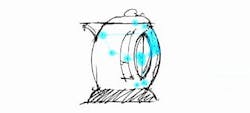Researchers can track what catches a designer's eye
Aneye-tracking system developed by researchers at The Open University and the University of Leeds (Leeds, UK) aims to remove the constraints on creativity imposed by computer-aided design (CAD) tools.
Traditional design tools, such as pen and paper, are increasingly being replaced by 2-D and3-D computerized drawing packages. The uptake of CAD is helping to increase productivity and improve the quality of designs, reducing errors and unnecessary wastage when the goods are made.
However, the switch to CAD often forces people to change how they work so they fit with the technology, rather than the other way around. According to Steve Garner, professor of design at The Open University, in creative disciplines, this inevitably constrains the results produced.
In the "Designing with Vision" project, the university researchers focused on an early stage in the design process that involves drawing, viewing, selecting, and manipulating shapes. This process is common to designers working in areas such as fashion, graphics, and consumer goods packaging.
Designers who work with shapes tend to intuitively home in on certain areas in initial sketches, using these as a starting point to move forward. However, this element of subconscious selection is difficult to replicate with CAD, because the software package is unable to "see" what might be catching the designer's eye.
To address this, researchers added eye-tracking technology to a CAD system, producing a system that could identify and select shapes of interest automatically within a drawn sketch, according to the designer's gaze.
The system was put through its paces by groups of designers to check that it worked in practice. The tests confirmed that the combination of eye-tracking technology and conventional mouse-based input allowed initial design sketches to be manipulated and developed according to the user's subconscious visual cues.
More information on the prototype design system is availableat the project web site.
-- By Dave Wilson, Senior Editor,Vision Systems Design
